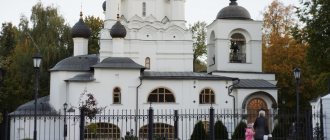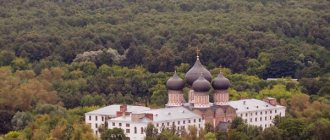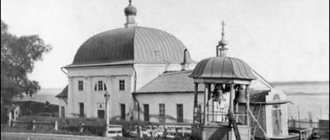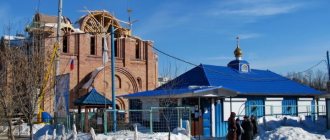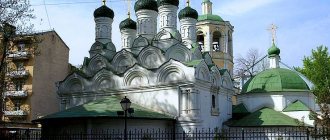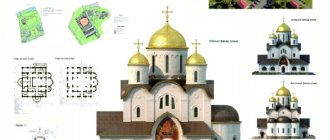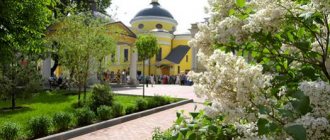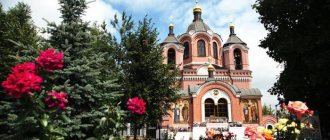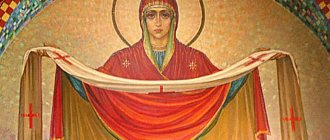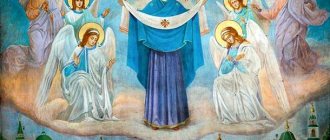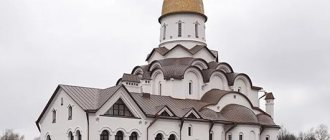Church of the Intercession of the Blessed Virgin Mary in Medvedkovo . The name of the village has been known since the 16th century. Then it was owned by the boyar V. Pozharsky, who was nicknamed “the bear” for his unprecedented physical strength. It is likely that the area got its name from the name of the first owner.
In the 17th century, Dmitry Pozharsky became the owner of the village.
It was on the territory of Medvedkov that during the Time of Troubles there was a militia that went down in history. Later, Dmitry Pozharsky will make the village his residence and, in memory of the events of the terrible time, will build a wooden Church of the Intercession of the Blessed Virgin Mary in Medvedkovo.
The significance of the Temple in the culture and history of Russia
The Church of the Intercession of the Blessed Virgin Mary in Medvedkovo is a unique building that reflects the processes occurring in culture and architecture in the mid-17th century. The building, made in the hipped style, characteristic of Russian temple architecture of the 15th-17th centuries, reflected its main features. Thanks to this, its description was included in many architectural textbooks as a classic example of a tented temple.
The historical significance of the Medvedkovo temple lies in the perpetuation of an important event in history - the liberation of Russian lands and their capital from Polish-Lithuanian invaders in 1612. The church, rising on the high bank of the river. Yauza, resembles an obelisk in honor of the heroes of the national liberation movement.
Who is it named after, the significance of the temple today
The Temple of Seraphim of Sarov in Raev received its name in honor of the main altar, consecrated in honor of the saint of the Russian land. Saint Seraphim was the founder and patron of the Diveyevo Convent and is revered as one of the most famous monks in the history of the Russian Orthodox Church. It is known that he was born in 1754, and in 1778 he became a novice in the Sarov wasteland.
Various hagiographies mention various stories from his childhood: one says that he fell from a bell tower and was saved by an angel, and another says that he became seriously ill and the Mother of God granted him healing during a religious procession. In 1786, Seraphim became a monk and soon began to live in solitude, as he always had a penchant for silence and the Jesus Prayer.
The description of his life preserved that he lived in a separate cell, where he was engaged in ascetic exercises, reading sacred books, and working in his own garden and beehives. His feat of pillar-bearing is also known, where the saint spent 1,000 days and nights on a boulder in unceasing prayer.
It is also noteworthy from his life that wild animals came to him, in particular, a bear, which the saint fed bread from his hands.
Many people of various classes came to Seraphim for spiritual guidance and advice, from whom he always refused to take anything as a reward or gratitude. The life describes a case of how one day thieves, deciding that the saint was hiding wealth in his cell, beat him and wanted to rob him, but found nothing.
After their attack, Seraphim received a back injury and remained hunched over forever, but he never held a grudge against anyone and forbade punishing his offenders. From 1807 to 1825, the saint accepted the feat of silence and seclusion, and after that he received the gift of clairvoyance and healing of illnesses.
The life of the saint was rewritten many times to make it comply with censorship, and during another edition new episodes were added, the truth of which is doubtful. The issue of canonization also caused problems due to the attitude of Saint Seraphim towards the Old Believers, since his own words or written instructions on this matter have not been preserved.
Today, the temple in Raev is not only a church in which believers can become participants in the sacraments, it is also a cultural center aimed primarily at young people.
In this area of Moscow there are many recently completed houses inhabited by young families, so the temple and its youth association become an important religious and moral beacon, providing the opportunity for social work and participation in the life of the city.
Location and how to get there
The Church of the Intercession of the Blessed Virgin Mary in Medvedkovo is located at st. Zapovednaya 52a.
The nearest metro stations are:
- Station “Sviblovo”, related to the orange branch. From here you can walk to the Pokrovsk Church or take a bus. For a walk, after exiting the subway, you need to turn left and move towards the large building of the shopping and entertainment center of the same name.
From there they turn left again and go towards the street. Kola, along which they go to the second Medvedkovsky bridge across the river. Yauza. Immediately after the bridge, they turn into a green zone, on the opposite side of which there is the Orthodox Church of the Intercession with the church adjacent to it. The described path will take 20-25 minutes. Approximately the same time will have to be spent traveling to the place by bus. When leaving the station, turn right and go to the public transport stop of the same name. Take bus number 380 to the stop “Ul. Zapovednaya” and reach a traffic light crossing located 100 m in the direction of travel. The right place is located 300 m from the crossing. - Bus route 605 runs from the Babushkino metro station You need to get out of it at the street stop. Polar. At the nearest crossing, cross the street and go straight to the street. Reserved.
- From the “Otradnoye” metro station located on the gray metro line, on the same route 605 you get to the “Pr.” bus stop. Dezhnev." they reach Zapovednaya Street, along which they descend to the temple.
How to get there[edit]
Address:
127081, Moscow, st. Zapovednaya, 52A
Telephone:
+7 (499) 186-86-47
Directions:
- Art. metro station "Otradnoe", then by bus 605 to the stop "Dezhneva Proezd, 32", then on foot for 5 minutes, or by minibus 280 to the stop "Ul. Zapovednaya,” the temple is located near the bus stop.
- Art. metro station "Sviblovo", then by bus 628 or minibus 280 to the stop "Ul. Zapovednaya,” the temple is located near the bus stop.
The history of Medvedkovo and the appearance of the temple
For the first time in the historical chronicles of the village. Medvedevo is mentioned in the 16th century. The origin of its name is connected with the first owner of this area, Prince Vasily Fedorovich from the Pozharsky family, nicknamed the Bear.
At the beginning of the next century, it was from here that militia detachments under the command of Prince Dmitry Pozharsky and merchant Kuzma Minin set off for Moscow.
It is believed that the Russian militia camp was set up on the site of the current temple.
10 years after the liberation of the Russian state from foreigners, Medvedevo became the main fiefdom of the glorious princely family.
The national hero ordered the construction of a wooden church in memory of historical events.
The choice of a tent-roofed architectural style was not an accident, since according to the established tradition in Russia, such religious buildings were built as monuments dedicated to important historical events. The belfry of the temple was decorated with a large bell, cast by order of the founder in honor of the recent victory over the Poles.
Due to frequent fires, the wooden building was demolished, and a white-stone tented temple was erected in its place, which has survived to the present day. The new extension had 5 aisles, the number of which was reduced to three at the end of the 17th century. At this time, the Medvedkovsky estate was owned by the favorite of Princess Sophia, Vasily Vasilyevich Golitsyn.
The new owner carried out a number of transformations of the religious building:
- Installation of a large gilded iconostasis in the main chapel.
- Replacement of all the bells of the belfry, on the main one the craftsmen placed an inscription confirming the right of the Golitsyn family to the estate near Moscow.
- Renewal of the collection of temple icons and valuables, the main one among which is the gospel, decorated with miniatures by Princess Sophia.
The next significant reconstruction of the religious building took place in the second half of the 18th century. during the ownership of Medvedkovo by the Naryshkin family.
The following modifications were made:
- reconstruction of open walkways into covered walkways;
- destruction of figured tiles decorating the tent;
- the formation of new window openings in the tent, octagon and main volume;
- turning round snare drums into octagonal ones;
- reconstruction of the bell tower;
- iron finishing of the tent.
In the 19th century With. Medvedkovo passed from owner to owner. But despite the frequent changes of owners, the Pokrovsky temple continued to be updated. One of the main innovations was the complete reconstruction of the bell tower in the classical style. The iconostasis and a number of large icons created in the 17th century were also updated.
During Soviet times, the temple continued its spiritual activities. Perhaps this is due to the fact that in the 20-30s. it was located outside the city limits of the capital. Until the end of the Great Patriotic War, services were held in the lower church.
In the 70s A significant restoration of the ancient religious building was carried out. In the wake of the revival of spiritual life in Russian society, a Sunday school began operating at the church, and a clergy house was built. The historical building is an architectural monument of federal significance.
Moscow north
Medvedkovo
★★★
And again about the same thing.
Church of the Intercession of the Blessed Virgin Mary in Medvedkovo
| Church of the Intercession of the Blessed Virgin Mary in Medvedkovo on Zapovednaya Street. |
The vast majority of us, modern Muscovites, live on the outskirts, in the so-called residential areas. This is where we spend a significant part of our time. But do we know the history of our region, our small homeland? Can we correctly explain at least this very name? What is hidden in the names of the districts “Bibirevo”, “Khimki-Khovrino”, “Sviblovo”? But these are the largest districts of Moscow, the population of which is comparable to a large city. Were there falcons on Sokol and bears in Medvedkovo? They may object to us that these, like other Moscow outskirts, are not Moscow, that these are former villages and hamlets that became part of Moscow 50, 40, 30 years ago. And what could be interesting in a residential area entirely built up with monotonous multi-storey “boxes”? However, in almost every modern outskirts its pearls have been preserved, serving as a bright decoration of modern areas: these are ancient churches and estates, many of which have now been restored and are experiencing a rebirth.
On the north-eastern outskirts of Moscow, where the Chermyanka River flows into the Yauza, there is a wonderful monument of Russian stone hipped-roof architecture of the first third of the 17th century, the Church of the Intercession of the Blessed Virgin Mary, in Medvedkovo. This temple is a monument to the national unification of Russia, the overcoming of the Time of Troubles, a visible embodiment of the political and cultural achievements of Russia in the second quarter of the 17th century.
The very name “Medvedkovo” as a fiefdom near Moscow has been known since the beginning of the 16th century. It was owned by the boyar V.F. Pozharsky, who was distinguished by his extraordinary strength and was therefore nicknamed the Bear. The area got its name from the owner’s nickname, which still remains today: Medvedkovo.
At the beginning of the 17th century, Prince Dmitry Mikhailovich Pozharsky, a man who played a unique role in saving the Fatherland from foreign intervention, became the owner of Medvedkov. During the decisive period of the Time of Troubles, it was on the territory of the former village of Medvedkova that the people’s militia of Dmitry Pozharsky and Kozma Minin made their last stop before the decisive battle with the Poles for Moscow. At this place, the Russian army prayed for victory and vowed either to die or to liberate the capital of the Motherland from the invaders. The Poles and Russians fought with extreme bitterness, for the victory of each side meant either a victory for Russia or its defeat. Moscow was taken by the Russians. So Medvedkovo made its contribution to the history of the Time of Troubles.
| Medvedkovskoe cemetery, April 22, 2006. |
After the end of the Time of Troubles, its hero Dmitry Pozharsky makes Medvedkovo his main residence near Moscow. In memory of the events of the Time of Troubles, Pozharsky erected a wooden tent church of the Intercession of the Virgin in Medvedkovo in 1620. The temple had one limit in the name of St. Peter of Alexandria.
The choice of the name of the Medvedkovo church is not accidental. In the Middle Ages, every step in a person’s life was comprehended, nothing was accidental; behind each name and denomination there was a memory of a particular event. For such a memorial monument as the Medvedkovo Church became, this was extremely important and relevant.
The construction of churches in honor of the Intercession was initiated by the reigning Romanovs (since the victory was extremely important for strengthening the new dynasty on the throne) by the construction of the Church of the Intercession in their ancestral estate of the village of Rubtsovo, and was taken up by I.N. Romanov, F.I. Mstislavsky, D.M. Pozharsky, who built in 1618 - 20s. wooden Intercession churches in their estates (Izmailovo, Fili, Medvedkovo, respectively). Later rebuilt into stone ones, all three temples have survived to this day and carry the memory of those distant events to descendants.
The choice of the location of the Medvedkovo church from the point of view of sacred topography is also very important and noteworthy. It is located on the way from Moscow to the Trinity-Sergius Monastery, the main monastery of the country, which steadfastly fought against the invaders during the Time of Troubles, which was in many ways the spiritual center of resistance and unity of Russian forces.
| Easter, 1994. Photo by Alexey Bondarenko. Alexey said that the green house of the parish priest, which was preserved until the summer of 2012, is interesting here. |
In 1634-1635, Dmitry Pozharsky rebuilt the church into a stone one, which can still be admired today. The reconstruction of the temple was also associated with important events in the life of the country and Pozharsky himself. In 1634, the Peace of Polyanovsky was concluded between Russia and Poland, according to which the Polish king renounced his claims to Moscow. And for Pozharsky, this event meant consolidating the fruits of victory in the liberation of the Motherland from the foreign yoke. In addition, the beginning of the 30s was marked in the life of Pozharsky by personal events: the end of the difficult voivodeship in Novgorod, intense military operations against the Poles near Mozhaisk and Smolensk, the death of his beloved son Fedor and his close-in-spirit Patriarch Filaret, the founding father of the new dynasty Romanovs. All this together caused Pozharsky’s desire to renovate the Medvedkovsky temple, connecting it with general ideas of a national scale and the most significant events of his life.
The current temple is an excellent example of ancient tent-roofed architecture. This is one of the last single-tent churches in Moscow architecture, the construction of which “as not corresponding to church rank” was prohibited by Patriarch Nikon in 1652. There is an inscription on the bell tower stating that this village belonged to Dm. Pozharsky. The prince also ordered bells with inscriptions telling about the history of the creation of the church and its owner. Standing on the steep bank of the Yauza, the Church of the Intercession was and is the main decoration of Medvedkov.
Due to the design features of the church, there are two churches in it: the main upper one in the name of the Intercession and the lower warm one in the name of the icon of the Mother of God of the Sign. The history of the limits is as follows: after the construction of the temple in 1634-1635. there were three of them: Znameniya, Varlaam Khutynsky and Anthony the Roman. The choice of thrones is by no means accidental, since they are all of Novgorod origin and are associated with the memory of Pozharsky’s stay as a governor in Veliky Novgorod: the Znamenskaya icon was and is the main shrine and intercessor of Veliky Novgorod and the entire Novgorod land from enemies, and Varlaam Khutynsky and Anthony the Roman are famous Novgorod ascetics who founded monasteries on the outskirts of the city that still exist today.
In 1652, the church was given a certificate for the consecration of the throne in the name of the 9 martyrs of Cyzicus. And again the choice is not at all random. The veneration of the 9 Martyrs of Cyzicus was extremely rare in Rus'. Commemorated on April 29th Art. style. And Prince Dm. Pozharsky died on the 9th day after this holiday (April 20, 1642). And exactly 10 years after the death of the prince, a letter was issued to consecrate the new throne. So in the Medvedkovo church the memory of the death of the hero of the Time of Troubles was immortalized. The inventory of the temple for 1690 indicates the presence of those same four chapels that have been preserved to this day: at the top - the main one in the name of the Intercession and the side ones: the northern 9 Martyrs of Kizichesk and the southern Venerable. Sergius, founded in the same 1690. Below is a warm church in the name of the Znamenskaya Icon. Throne Rev. Sergius of Radonezh was founded by Golitsyn.
Cemetery, view from the bell tower, May 9, 2013.
Photo by Alexey Bondarenko.
The further history of the village is as follows. The Pozharsky family ended with his grandson Yuri Ivanovich (1682). The village went to the treasury, and in 1687 Princess Sophia granted it to her favorite Prince Vasily Vasilyevich Golitsyn, who owned it until Peter’s disgrace in 1690. Under him, Medvedkov flourished. Golitsyn paid special attention to the decoration of the temple. It was he who initiated the renaming of the chapels in their present form, and also invited a team of craftsmen to create iconostases that are still preserved.
At the bell tower, view of Zapovednaya Street, May 9, 2013.
Photo by Alexey Bondarenko.
The magnificent five-tiered iconostasis of the main temple dates back to the end of the 17th century. The famous Belarusian master Karp Zolotarev allegedly took part in its creation, who in the same years created the iconostasis in the famous and famous Russian church, a masterpiece of the “Nyryshkin baroque” Church of the Intercession in Fili. The iconostasis of the lower church was created at approximately the same time as the upper one: judging by the stylistic features, we can say that it was also created by Karp Zolotarev or his students.
Sofya loved Medvedkovo and often visited here in the summer. After walking through a beautiful birch grove, you could immediately catch a wide variety of fish bred in the pond, feed beautiful swans and deer, ride through the picturesque surroundings on thoroughbred horses, and then relax in a beautiful palace.
Medvedkovo village and temple , 1998.
Photo by Alexey Bondarenko.
Sophia also loved the Medvedkovo church and stood at services for a long time. Being artistically gifted, it was for this church in 1681 that Sophia created beautiful color miniatures for the altar Gospel, which was kept in the church. Now the Medvedkovsky Altar Gospel of 1681, included in the storehouse of Russian art and culture, is in the Historical Museum.
However, the rapid rise of Medvedkov, which began under Golitsyn, was short-lived. In 1690, the precocious Peter I came of age and was to become king. But Sophia, who was officially the regent for her brothers, did not want to transfer the throne to the matured Peter (the feeble-minded John was not taken into account). A conspiracy was hatched to eliminate Peter.
| View of the church from the bridge on Kola Street. Photo by A. Deryugin. |
However, the future transformer of Russia managed to reveal it in time and neutralize the conspirators. Among them was, of course, V.V., so dear to her heart. Golitsyn. It was from here, from his beloved Medvedkov, that Golitsyn, taken into custody, was taken to the Trinity-Sergius Lavra to Peter, where the former omnipotent favorite was deprived of his boyar rank, all privileges and exiled to Kargopol. And Medvedkovo, along with all other possessions, was assigned to the sovereign, according to the widespread practice of that time. In the same year, after Golitsyn’s disgrace, a detailed inventory of the estate was compiled, from which we know about Medvedkov’s heyday under Golitsyn.
Peter handed over the confiscated village to his uncle L.K. Naryshkin, in whose family it was for more than a century: from 1691 to 1795. Under them, the village fell into decay. So, in 1704, only 8 peasants lived in Medvedkovo and 9 soldiers were on duty at the outposts of the Trinity Road.
At the beginning of the 19th century, the way of life in the village changed for the better, and there was an influx of population. The nobles and factory owners who owned the village populated it with purchased serfs. Thus, under the landowner Schmidt in 1809, 205 serfs already lived in Medvedkovo. Then in 1812, Schmidt sold it to the merchants A.G. Sungurov and N.M. Gusyatnikov, who divided the territory of the estate, and Medvedkovo itself remained with the Sungurov family (until 1890). The last owner of the village was N.M. Shurupenkov.
| The outskirts of the village of Medvedkova, 1937 or 1938. A three-legged power line pole can be seen to the right of the church. As in our days, the outskirts of the village were a favorite vacation spot. Photo from the family archive of Dmitry Lobov. |
From the second half of the 19th century. Medvedkovo is beginning to increasingly turn into a popular summer cottage area in the Moscow region, and former serfs are beginning to rent out their houses for the summer to summer residents coming from Moscow. Artists K. Korovin and M. Vrubel vacationed here, and the future poet V. Bryusov, as an eleven-year-old boy, in 1884 left an enthusiastic children's review for the children's magazine “Dushevnoye Slovo” about a wonderful time in Medvedkovo. The Church of the Intercession was also honored in painting. In the Moscow Museum of V. A. Tropinin and the artists of his time there is a painting by V. E. Raev (1808-1871), depicting the church along with the picturesque surroundings.
After 1917, Medvedkov’s life changed dramatically. The former estate housed various office establishments.
In Soviet times, the temple was not closed, but services before the Great Patriotic War were held only in the lower warm aisle. After 1945, the temple was repaired, so that they began to serve in the upper church under the leadership of its long-term rector, Archimandrite Sergius (Savelyev). He also ordered the inscription “CROSS—VICTORY OVER DEATH” to be made on a large nameless marble cross found among the remains of the Medvedkovo cemetery, after which the cross was erected in front of the church.
Wooden manor house in Medvedkovo. Photograph of 1932. Park facade.
According to literary information, the house was built in the middle of the 19th century. However, already on the plan of the Moscow surroundings of 1821, a house with a couple of outbuildings on the sides is shown at this place, and it is much more likely that it was this house that was preserved in the future, only its decoration was partially changed. A stone staircase with an intermediate platform descends the slope into the park.
In the 1930s, the house was used as a children's sanatorium. His further fate is unknown. (based on materials from the book “ Architectural Monuments of Moscow. Neighborhoods of Old Moscow (northwestern part of the territory from Kamer-Kollezhsky Val to the current border of the city)
", 2004).
In 1960, after the construction of the Moscow Ring Road, Medvedkovo became part of Moscow, and soon became a mass development area. Since the early 1970s. The village began to be gradually demolished and ten years later was completely destroyed. In its place grew one of the largest “dormitory” districts of Moscow with a population of over 200 thousand people. The church that has survived from the village is a bright and main decoration of a huge area, entirely built up with insignificant “boxes”. And she can tell an interested Muscovite a lot about the glorious past of our Fatherland.
Materials used when writing this article:
website of the Prefecture of the North-Eastern Administrative District of Moscow https://svao.mos.ru,
website https://kalinovca.narod.ru,
website https://www.pravoslavie.ru.
Maria Dudaleva. Temple of the Intercession in Medvedkovo // Vitamin. — No.5.
(presumably between 2004 and 2006)
View from the right bank of the Yauza towards the Old Medvedkovsky Bridge
.
Photo by Maxim Korolev, 1998 (transferred by the author to the Northerners in the fall of 2004). Author's comments are in italics.
In this place there was an old wooden bridge over the Yauza, which burned down in 1984-85
.
Even in the polluted Yauza, such water lilies can grow
.
back forward
Medvedkovo and surroundings
Moscow north
The architecture of the temple and its interior decoration
The Church of the Intercession of the Blessed Virgin Mary is a classic example of a tent-type building, which is based on a structure consisting of a squat figure of eight, mounted on a low square base and covered with a high hipped dome.
At all four corners of the base square there are octagonal drums topped with onion-shaped domes. The base of the tent and snare drums are decorated with rows of semicircular and keel-shaped zakomaras. The main volume of the temple is installed on a high basement, which houses a warm single-altar church, consecrated in the name of the Sign of the Mother of God.
The main part of the temple is adjacent to symmetrical chapels, which are covered with a hipped roof and topped with small domes on narrow drums. The multi-stage structure of the temple is emphasized by the apse, consisting of three semicircular parts, which are connected by semi-columns.
It has a stepped shape, since the altar part of the lower church is significantly elongated in the eastern direction. The temple bell tower adjacent to the western facade was rebuilt several times. The modern building was erected in the nineteenth century in the classical style.
It consists of 2 square tiers, ending with a helmet-shaped dome with an elongated spire. In the lower tier there are three arched portals, which are entrances to the closed porch. On the second tier there is an open belfry with arched window openings. The interior of the temple has two levels. At the bottom is the Church of the Mother of God of the Sign.
And in the upper part there is a temple in the name of the Intercession of the Most Holy Theotokos, which has the following limits:
- Intercession of the Blessed Virgin Mary (main);
- St. Sergius of Radonezh (northern);
- nine martyrs of Kizi (southern).
- The walls of both levels are covered with whitewash and decorated in some places with colorful lush paintings. They also contain numerous icons placed in carved gilded icon cases, some of which are covered with wooden openwork canopies. The main body of the ancient iconostasis is covered with crimson paint and decorated with gilded decorative elements.
Despite its small size, the temple does not seem like a dark and gloomy place. Sufficient lighting is provided by large arched windows and large chandeliers imitating antique candle chandeliers.
Architecture Features
This is one of the most unique architectural ensembles in Moscow - a tent-type structure. This is one of the last such buildings, because after Nikon’s reforms, such structures became prohibited.
The cathedral belongs to the medieval culture of Russian architecture. The building consists of two tiers: the insulated lower one, where the Church of the Sign of the Blessed Virgin Mary is located, and the upper one with the main altar of the Virgin Mary. There are two limits to it.
The temple was built in the style of tent architecture, which was very popular in the XIV-XVI centuries. The church we are studying, according to the observations of historians and art critics, has similarities with the most famous temple on Red Square - St. Basil's Cathedral. (See how to get rid of envy?)
All architectural structures of the tent type are built according to a similar scheme. An octagon is placed on the quadrangle (the base of the cathedral). It forms the basis of the tent. Despite this, the architects decorated each building so inventively that not all lay people were able to notice the similarities. A feature of such cathedrals was the absence of pillars; the entire weight of the building was supported on the walls. This explains the elongated shapes and the impossibility of building large-scale tents.
The cathedral stands on a high foundation, completed with domes. The combination of all the components of the cathedral forms a holistic image, with refined grace, harmony and airiness. The height of the tent is equal to the bottom of the cathedral.
Unlike their predecessors, quadrangles use a hipped roof. The altar represents a staircase composition completed by a chapter. On each side of the base there are rows of “kokoshniks” (onions). A pyramidal image of a tented cathedral appears before us.
The bell tower, built in a similar style, is made of two tiers. It was radically changed in 1840.
What are they asking Spyridon of Trimifuntsky for?
Who does the saint patronize and how should one pray to him? Where are the relics of Spyridon kept and how does he differ from other canonized saints?
In the first century, the galleries of the church were not covered and resembled the structure of the passages at St. Basil's Cathedral.
Not long ago, during restoration work, a carved stone was discovered on one of the facades of the bell tower. It depicts a double-headed eagle. This suggests that the royal family constantly came here.
The Gospel of 1681 is of particular value for artists, researchers of painting and architecture. It is made in the form of miniatures. The legend says that the author of the amazingly subtle and elegant work was Princess Sofia.
The iconostasis was created by masters in 1680, the work was supervised by Karp Zolotorev. The next changes were made only two centuries later, after the war.
Famous icons of the cathedral
The Church of the Intercession of the Blessed Virgin Mary in Medvedkovo has a large collection of ancient icons.
The most famous of them are:
- The miraculous icon of the Intercession of the Mother of God, located to the left of the main iconostasis under an openwork gilded canopy. The icon depicts the Mother of God holding in her hands a large headscarf that once sheltered the inhabitants of Constantinople from the attack of the Saracens. In front of the icon they ask for the preservation of physical and spiritual health, protection of housing and life, and healing of ailments.
- Icon of the Sign of the Blessed Virgin Mary - an ancient image, which is a revered list of the miraculous Novgorod image. By praying to her, believers receive protection from enemies and natural disasters, find family peace and inner peace. The icon is located in the lower level of the Pokrovsky Church.
The main iconostasis in the Church of the Intercession of the Blessed Virgin Mary in Medvedkovo - In the corresponding limit is the image of the venerable Sergius of Radonezh - the founder of East Slavic spiritual culture and monastic cenobitic rules. Prayer helps him achieve success in his studies, overcome his own pride and intolerance, and improve his living conditions.
- Icon of the 9 Kizian Martyrs depicts the holy preachers of the late 3rd century who brought the Word of God to the inhabitants of the pagan city of Cyzicus. They were martyred, but 40 years later they discovered incorrupt remains, over which a cathedral was erected. The icon helps to recover from various diseases and find a job.
Among the valuable temple relics was a Gospel decorated with miniatures, the authorship of which is attributed to the sister of Peter the Great, Princess Sophia. After 1918, the relic is considered lost. But now traces of it have been found in the Russian Museum, where the corresponding clarifications are being carried out.
Rare icons
The oldest icons are considered to be the icons of the Most Holy Theotokos and the Old Testament Trinity, which have been in the temple since the end of the 17th century. The festive row is represented by icons of the Nativity of the Blessed Virgin Mary, Epiphany, Resurrection of Christ and Ascension.
The Last Supper icon is located above the royal doors and is made with oil paints, painted in the 18th century. In the chapel of Sergius of Radonezh on the second floor there is an icon of the Cathedral of the Reverend Elders of Optina with particles of relics.
The ancient icon of the Sign, located in the local row of the iconostasis, receives special attention from parishioners. They come to thank Mother and ask for a blessing.
Social work
The Church of the Intercession of the Blessed Virgin Mary, located in the capital's Medvedkovo district, carries out active social work. The activities of clergy and caring parishioners are aimed at helping various categories of the population.
- The clergy of the temple, as well as voluntary volunteers, provide assistance to the pupils of the Scarlet Sails centers and organize leisure and free time for children. They introduce them to the basics of the Orthodox faith, the life of the church community, and interesting people who live in accordance with traditional Christian values. Pupils of the center conduct joint prayers and read akathists in prayer rooms specially equipped at the centers. Orthodox holidays are organized for them, during which the meaning of the celebration and its origin are explained. There are plans to organize Sunday school classes for children with special needs.
- An important part of social service is helping the elderly and people with limited mobility. They are provided with transportation to the temple for services, pilgrimage trips to the capital's churches, home-based communions and unctions. Clergy and volunteers help this category of parishioners solve everyday problems and try to compensate for the lack of communication and attention.
- The parish charity service surrounds large families living in the parish. They are provided with spiritual and material assistance, consisting of the provision of clothing, food and stationery items.
- To ensure the activities of the church charity service, charity fairs are regularly held at which toys and handmade crafts, church literature, and stationery are sold.
- Priests correspond with imprisoned people, providing them with spiritual support, instructing them in the fundamentals of the Christian faith and Orthodox traditions. Prisoners are congratulated on church holidays and provided with church literature.
- Clergy conduct conversations with people who find themselves in difficult life situations and provide them with prayerful support.
To carry out social service, the clergy of the Pokrovsky Church require the help of volunteers who are not indifferent to the life and problems of the people around them and are ready to provide them with free assistance.
Architect, exterior decoration, architectural ensemble
Today the temple is a large-scale architectural complex. In addition to the temple building, there is a separate baptismal church, utility buildings, a Sunday school building, workshops and a spiritual and educational center building. From a distance, the temple ensemble can be mistaken for a monastery building.
The architect and author of the project was A. A. Mamonov, a famous artist and participant in Project-200.
More than 15 temples from the list have already been built according to his designs, and construction continues. In his works, A. A. Mamonov focuses on various stylistic and practical solutions, based on historical styles in the construction of the temple and at the same time using elements of modern architecture.
The height of the temple is 43 m, the total area is more than 1,000 square meters. m, the temple is in keeping with the traditions of Russian architecture and was built according to the models of ancient Russian churches. The temple has an unusual dark roof and three onion domes: one central and two on the side aisles.
The temple is divided into three apses and has an upper and lower temple. Externally, the temple is covered with white facing material. The domes are covered with a dark roof. There are architectural decorations on the walls, window sills and tops of the windows.
Sunday school at the temple
The Church of the Intercession of the Blessed Virgin Mary in Medvedkovo conducts educational work with parishioners of all ages. Classes in the Sunday parish school began in the early 90s. XX century
Classes with children are conducted by clergy and professional teachers in the form of educational conversation and dialogue. They are aimed at forming in the younger generation a model of a pious lifestyle based on traditional values and basic Christian commandments.
The children's education program includes the following activities:
- foundations of the Christian religion and history of the Church;
- church art;
- study of the Old Church Slavonic language;
- choral singing classes;
- needlework;
- visual activity;
- participation in church theatrical productions.
Children aged 6-14 years old can attend free classes on Sunday, who are divided into 4 age groups. The full course of study lasts 4 years. Not only children, but also adults who strive to learn the Orthodox faith and life in the bosom of the Christian Church can attend Sunday school. People of any age can come to classes.
Attending Sunday school is not only an opportunity to receive basic religious education, but also a chance to expand your social circle, find like-minded people, broaden your horizons and unleash your creative potential. As in the children's school, classes are conducted free of charge by the clergy of the Pokrovsky Church.
Representatives of the older generation are taught:
- theology;
- Holy Bible;
- history of the Church and the Orthodox faith.
In addition, church choral singing, art and law are studied. Attention is paid to teaching the Church Slavonic language and liturgical rituals. The course of study lasts 3 years, at the end of each of which exams are held. After 3 years, adult students receive a document confirming their completion of Sunday school.
Sunday school students take part in pilgrimage and educational trips organized by a special pilgrimage service. In addition, summer holidays in an Orthodox camp are organized for children studying at the school.
Clergy and mentors
The Church of Seraphim of Sarov in Raev has a full-fledged parish staff. The rector of the church today is Archpriest Alexey (Yakovlev), a candidate of theology, the head of the project for the revival of wooden churches of the North and a teacher of Orthodox culture at the Moscow Military Academy.
The second priest is Hieromonk Nikodim (Dorozhkin), winner of the Sergius of Radonezh medal, 1st degree, for his services and contribution to the development of the church. Priests Nikolai (Zorin), Nikita (Ivanov) and Grigory (Shinov) also serve at the temple. All priests are engaged in social work, Sunday school, perform divine services, and have church awards.
Opening hours and services at Pokrovsk Church
The Church of the Intercession of the Blessed Virgin Mary is open daily from 8 am to 8 pm. At this time, services and excursions are held, the exact schedule of which can be clarified by calling the temple information service and on the official website of the church organization.
In general, the schedule of services is as follows:
| Day of the week | Time | Divine service |
| Monday | 8.00 | Morning Liturgy |
| Tuesday | ||
| Wednesday | ||
| Thursday | ||
| Friday | ||
| Saturday | 8.00 18.00 | Morning Liturgy All Night Vigil |
| Sunday | 7.00 10.00 17.00 | Early liturgy Late Liturgy All-night vigil |
On general church and patronal holidays, services are held according to the Sunday schedule.
Where is it located, what is in the surrounding area, how to get there
Not far from the Church of Seraphim of Sarov there is the Medvedkovo metro station. The journey from the station to the temple will take approximately 10-15 minutes on foot. Shuttle buses also go towards Raevo, stopping opposite the temple, these are routes No. 50, No. 166, No. 412, No. 554. The temple is tall enough to serve as a landmark.
Near the temple there is the Yauza River, the Suvorov Military School and an eco-park, open 24 hours a day, with recreational facilities, bike rental, paths and access to the water. The Church of Seraphim of Sarov is a young and at the same time very promising temple and parish, aimed at various social work, helping those in need and constant interaction with young people.
For Raevo, the temple became a kind of religious “pearl”, a spiritual landmark, and a place for communication with others.
Author: Katya Volkova
Article design: Oleg Lozinsky
Interesting facts about the temple
From the very beginning of the construction of the temple, there is historical information that deserves attention:
- The Church of the Intercession of the Blessed Virgin Mary is the largest tent-roofed building in Russia. Its size is only slightly inferior to the Ascension Church in Kolomenskoye.
- The Church of the Intercession is one of the last tented religious buildings erected before the ban of Patriarch Nikon. Which prohibited the construction of such structures, considering them not to comply with Orthodox canons.
- Initially, the side limits of the upper temple were consecrated in honor of Varlaam of Khutyn and Antorius the Roman - saints who made a great contribution to the spiritual development of the Novgorod land. This choice was due to the rather long stay of Prince Dmitry Pozharsky as governor of Novgorod.
- Over its 400th history, services in the temple have not been interrupted for a single day. Located in the northern suburbs of the capital, Medvedkovo was not plundered during the Patriotic War of 1812. During the years of Soviet power, the temple escaped desecration and closure due to the suburban status of the village. And during the Great Patriotic War, services were held in the lower warm church.
- In Medvedkovo at the end of the 19th century. The great Russian painters Konstantin Korovin and Mikhail Vrubel rested. Childhood impressions from contemplating the building were reflected in the works of Valery Bryusov.
- Today the temple is located in a park area, so it is quite difficult to assess its volume and beauty, but its regular parishioners note the special aura of prayer that this place has.
The Orthodox Church of the Intercession of the Blessed Virgin Mary is the center of spiritual, social and cultural life not only in Medvedkovo, but throughout Moscow.
The historical building is of interest to both Christian believers and lovers of architecture and history of the Russian state. The clergy of the Pokrovsk Church perform all church rituals and devote a lot of time to social service.
Article design: Mila Friedan
Interior decoration of the Church of the Intercession of the Blessed Virgin Mary.
A beautiful and festive inner temple, quite bright from the windows and faces of saints. Inside the church the iconostasis is classic high. Each row is displayed with icons according to church canons. The iconostasis is crowned with the crucifixion of Christ.
The icons are framed in gilded carved frames. From each wall the face of the Saint looks at the entrance. Believers each come to their own icon, and during the service they turn to the central iconostasis.
Many of the icons are ancient, painted by masters of the 18th century. The work in the temple is being protected and restored. Several icons appeared in the 20th century.
